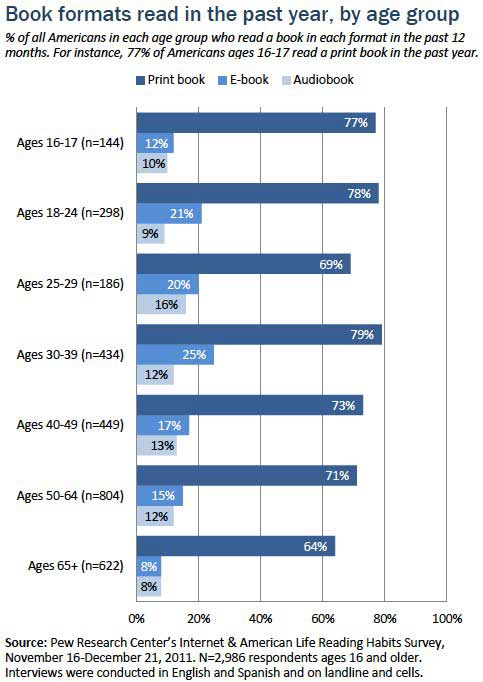DOES IT SEEM that reading a book is an old-fashioned practice for many young people? One that has given way to alternative, less-wordy pastimes like texting and tweeting? In actuality, young Americans are more likely to read a book than their older peers, says Kathryn Zickuhr, the lead research analyst for a Pew Research Center report on youth literacy and reading habits.
Zickuhr says, “They are [also] more likely to have used the library in the past year, especially the 16- and 17-year-olds. Something interesting for me is that those younger age groups were actually more likely to have gotten research assistance from a librarian, and they were more likely to have borrowed print books than the older ages.”
According to the report, which is part of the Pew Internet & American Life Project, young Americans between the ages of 16 and 29 are reading print and e-books at a furious pace, seeking out library books for school, work, and pleasure and reading news reports online to keep up with world events. Here are a few of the main findings:
83 percent of Americans between the ages of 16 and 29 read a book in the past year. Some 75 percent read a print book, 19 percent read an e-book, and 11 percent listened to an audiobook.
Among Americans who read e-books, those under age 30 are more likely to read their e-books on a cell phone (41 percent) or computer (55 percent) than on an e-book reader such as a Kindle (23 percent) or tablet (16 percent).
Overall, 47 percent of younger Americans read long-form e-content such as books, magazines, or newspapers. E-content readers under age 30 are more likely than older e-content readers to say they are reading more these days due to the availability of e-content (40 percent vs. 28 percent).
60 percent of Americans under age 30 used the library in the past year. Some 46 percent used the library for research, 38 percent borrowed books (print books, audiobooks, or e-books), and 23 percent borrowed newspapers, magazines, or journals.
“Anecdotally, a few people said that when they found out about library e-books, this helped them start using the library again,” Zickuhr says, adding that more Pew research will be coming out about how people use libraries and how libraries are adjusting to their patrons’ modern and digital needs. She says most readers consider e-books a supplement, not a main reading device. “These people said they are now browsing print stacks more because e-books built a door to library services.”



It seems odd that you would restrict this article, since it’s freely available to anyone on the Pew website, at http://libraries.pewinternet.org/2012/10/23/younger-americans-reading-and-library-habits/
In any case, the article does not in any way prove that 16-17 yr. olds read more than over-65s except in the technical sense that forces them to, as school demands. Which proves nothing, though it makes a great headline.
We didn’t mean to restrict this one. It’s not open to the public because, as you point out, it’s available on the Pew website.